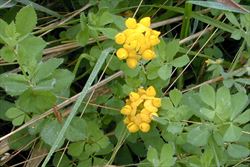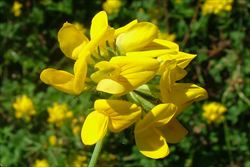Click on images to enlarge

infestation (Photo: Sheldon Navie)

habit (Photo: Forest and Kim Starr, USGS)

habit (Photo: Sheldon Navie)

flower clusters and leaves (Photo: Forest and Kim Starr, USGS)

flowers (Photo: Forest and Kim Starr, USGS)

close-up of flowers (Photo: Sheldon Navie)

immature fruit (Photo: Sheldon Navie)

mature fruit (Photo: Jackie Miles and Max Campbell)
Scientific Name
Lotus uliginosus Schkuhr
Synonyms
Lotus corniculatus L. (misapplied)Lotus major Scop.Lotus pedunculatus Cav. (misapplied)
Family
Fabaceae (Queensland, the ACT, Victoria, Tasmania, and the Northern Territory)Fabaceae: sub-family Faboideae (New South Wales)Leguminosae (South Australia)Papilionaceae (Western Australia)
Common Names
big trefoil, bird's-foot trefoil, greater bird's-foot trefoil, greater birdsfoot trefoil, greater lotus, greater trefoil, large bird's foot trefoil, lotus
Origin
Native to northern Africa (i.e. northern Algeria, northern Libya, Morocco, Tunisia and northern Egypt), the Azores, the Madeira Islands, the Canary Islands and most of Europe (i.e. Denmark, Sweden, Ireland, the UK, Austria, Belgium, Czechoslovakia, Germany, the Netherlands, Poland, Switzerland, Estonia, Latvia, Lithuania, western Ukraine, Albania, Bulgaria, Greece, Italy, Romania, Yugoslavia, France, Portugal and Spain).
Naturalised Distribution
Widely naturalised in southern and eastern Australia (i.e. in south-eastern Queensland, eastern New South Wales, Victoria, Tasmania, south-eastern South Australia and south-western Western Australia).
Also naturalised in New Zealand, La Réunion, southern South America (i.e. Argentina and Chile), Canada, the USA and Hawaii.
Notes
Greater bird's-foot trefoil (Lotus uliginosus) is widely regarded as an environmental weed in Victoria and is sometimes seen as being invasive is natural areas in South Australia, New South Wales and Western Australia. This species has been widely cultivated as a pasture legume in the temperate regions of Australia. It has escaped cultivation and become a weed of roadsides, disturbed sites, cultivated areas and natural vegetation. Greater bird's-foot trefoil (Lotus uliginosus) prefers moist sites and is most often found in pastures on poorly-drained acidic soils. However, it also often invades grasslands, grassy woodlands, winter-wet areas, creeklines, riverbanks, swamps and wetlands.
In Victoria, greater bird's-foot trefoil (Lotus uliginosus) is regarded as a very serious threat to one or more vegetation formations. It is a common weed species in coastal headland scrub and estuarine wetlands and is considered to be a threat to the integrity of peatlands and spring soak wetlands in the highland areas of this state. It has also been recorded in conservation areas in Vicotria (i.e. Morwell National Park and Yarra Bend Park), New South Wales (i.e. Kosciuszko National Park and Ironbark Nature Reserve) and South Australia (i.e. Kyeema Conservation Park, Finniss Conservation Park and Scott Creek Conservation Park).
During a recent survey, greater bird's-foot trefoil (Lotus uliginosus) was found to be one of the most common weed species and one of the most serious threats to wetland ecosystems on the Fleurieu Peninsula in South Australia. It is also a common weed of montane peatlands and swamps in New South Wales, which are endangered ecological communities in this state.

